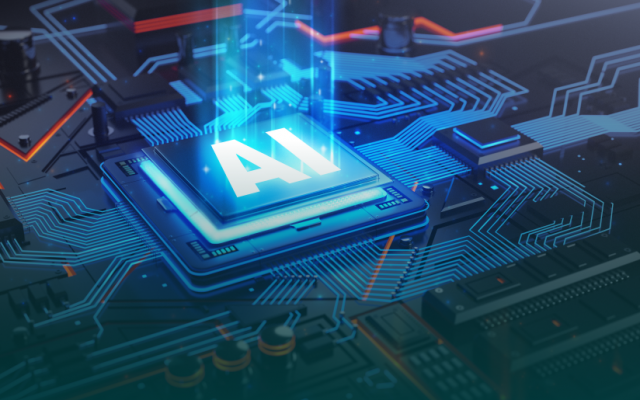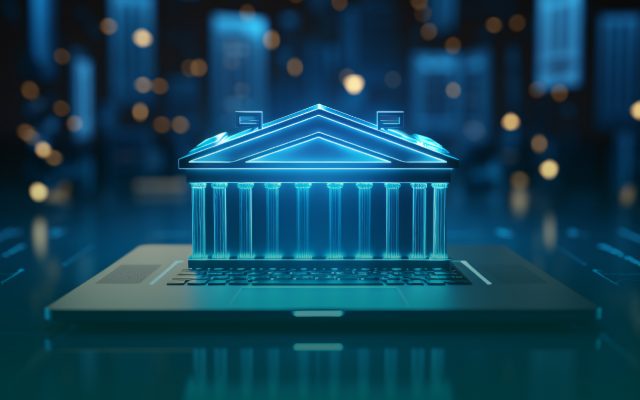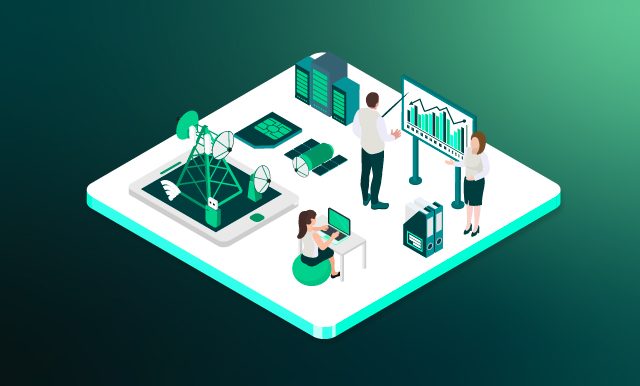The 21st century has witnessed an unprecedented digital revolution changing the future of education. As we stand at the crossroads of a rapidly evolving new technology in education, it’s essential to recognize the pivotal role computers and innovative devices play in shaping the future of learning in all population groups.
A study conducted by the Public Broadcasting Service (PBS) on the integration of technology in K-12 classrooms unveiled that a substantial 81% of teachers are of the opinion that tablets serve to enhance the quality of classroom education. Furthermore, the survey established that an impressive 77% of educators observed that technology plays a pivotal role in boosting student motivation to learn.
At Forbytes, we are well-informed about the latest trends in educational technology and stand prepared to assist you in seamlessly integrating innovative solutions into your educational platforms, e-learning apps, or websites. We’ll support you in staying current with technological trends in education, including AR, VR experiences, and AI-based learning helpers. Don’t hesitate to reach out to our educational software development specialists for further guidance and support.
Benefits and Challenges of Using Technology in Education
In recent years, we’ve witnessed a significant shift toward online learning. This transformation, accelerated by global events like the COVID-19 pandemic, has both benefits and challenges. Online education has expanded access to learning opportunities, transcending geographical boundaries. It offers flexibility for learners of all ages, allowing them to balance education with work, family, and other commitments. However, it also presents challenges, such as the digital divide and the need to adapt traditional teaching methods to the online environment.
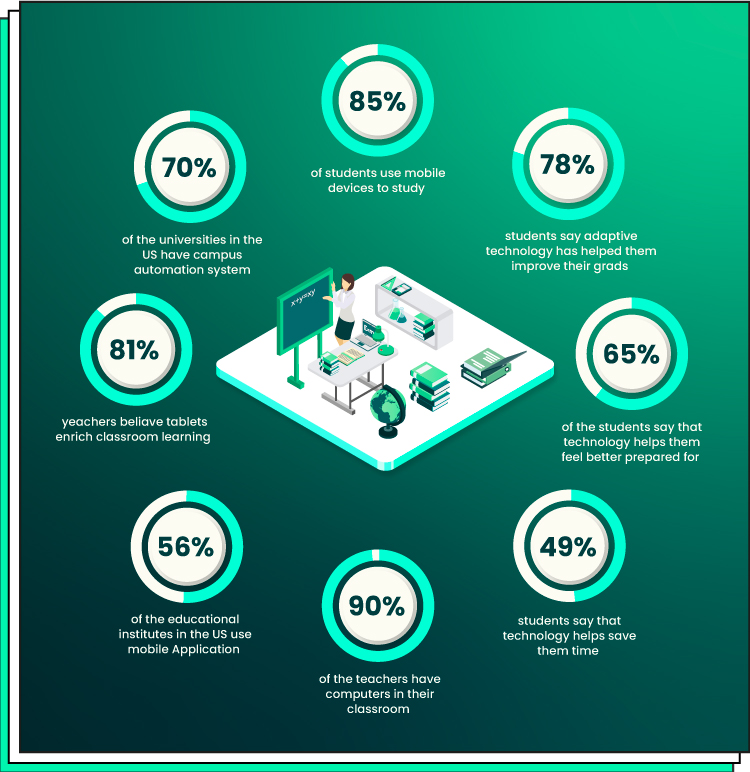
Role of EdTech Tools and Platforms: The Future Is NOW
Educational Technology (EdTech) has become a ubiquitous term in modern education, representing a pivotal domain that shapes the future of education. It encompasses a broad spectrum of tools and platforms designed to enhance the learning experience. From Learning Management Systems (LMS) that facilitate content delivery and assessment to interactive apps and digital textbooks, EdTech is transforming the way educators teach and learners engage with the material.
The Top 13 EdTech Tools & Solutions for Modern Education
Trends in educational technology include the following tools:
- Webinars. Webinars are live online seminars that allow for real-time interaction between educators and learners. They often include features like chat, polls, and Q&A sessions.
- Learning Management Systems (LMS). LMS platforms like Moodle, Blackboard, and Canvas facilitate the delivery of course content, assignments, and assessments in a centralized digital environment.
- Interactive apps. Educational app development comes in various forms, including interactive quizzes, flashcards, and simulation tools that engage students in learning through interactivity.
- Augmented Reality (AR) and Virtual Reality (VR). AR and VR technologies create immersive learning experiences, allowing students to explore subjects in 3D or augmented environments.
- Digital textbooks. Digital textbooks offer a more dynamic and multimedia-rich learning experience compared to traditional printed textbooks. They often include videos, animations, and interactive exercises.
- Artificial Intelligence (AI). Custom AI-powered platforms can provide personalized recommendations, assess student performance, and offer adaptive learning experiences.
- Big Data and analytics tools. Data analytics solutions like Tableau and Power BI help institutions collect and analyze data to improve teaching and learning outcomes.
- Video conferencing tools. Platforms like Zoom and Microsoft Teams enable real-time video and audio communication, making remote learning and virtual classrooms possible.
- Collaboration tools. Tools like Google Workspace (formerly G Suite) and Microsoft Office 365 offer collaborative document editing, shared calendars, and cloud storage, facilitating group projects and communication.
- Gamification platforms. Gamification tools and platforms like Kahoot and Quizlet use game-like elements to make learning more engaging and fun, particularly for younger learners.
- Podcasts. Educational podcasts provide audio content on a wide range of topics, allowing learners to consume information on the go.
- Simulations. Simulations and virtual labs, like those used in science and engineering courses, provide hands-on experience in a digital environment.
- Cloud-based storage and collaboration. Cloud platforms such as Dropbox and Google Drive offer easy access to documents and facilitate collaborative work on projects.
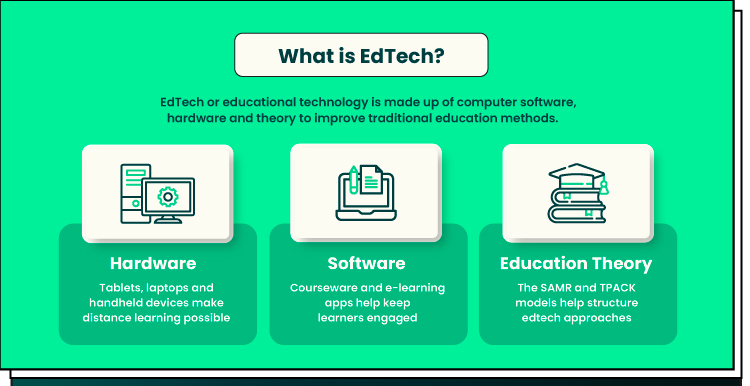
The 5 EdTech Platforms Everyone Knows
Several prominent platforms have embraced innovative technological trends in education to provide a wide range of learning opportunities. Each of these platforms offers a distinct approach to education, catering to the diverse needs of learners worldwide:
- Coursera. Coursera offers a wide range of online courses, specializations, and even full degree programs in partnership with universities and organizations from around the world.
- edX. Founded by Harvard and MIT, edX provides access to high-quality courses from top universities, colleges, and organizations. They offer both free and paid courses.
- Khan Academy. Khan Academy is a non-profit organization that offers free educational content, particularly in math and science, through a vast collection of video lessons and exercises.
- Udacity. Udacity focuses on providing courses and nanodegree programs in areas like programming, data science, artificial intelligence, and self-driving cars.
- Duolingo. Duolingo is known for its language-learning platform that offers courses in a gamified, user-friendly format, making it accessible to learners of all ages.
Personalized Learning Experiences Enabled by Technology
One of the most exciting technology trends in education is the ability to personalize learning experiences and here’s how this works:
- Adaptive learning algorithms. Advanced algorithms analyze student progress, identifying strengths and weaknesses to dynamically adjust the curriculum for personalized learning.
- Tailored content. Recognizing diverse learning needs, educators provide customized content, catering to both high achievers and those in need of additional support.
- Individualized pacing. Technology empowers students to learn at their own speed, promoting in-depth exploration and understanding without the constraints of uniform classroom timelines.
- Continuous assessment. Real-time monitoring enables educators to provide timely guidance when students encounter challenges, ensuring ongoing progress.
- Enhanced engagement. Personalized learning, driven by technology, boosts student motivation and enthusiasm by delivering relevant and engaging content, positively impacting academic performance.
VR and AR Applications in Education
To provide you with an impressive example of the future of technology in education, we’d like to focus your attention on the domain of high-end technology — enterprise learning systems in space exploration. NASA is among the leading organizations that actively adopt sophisticated technological trends in the education of their staff, which demonstrates the value and effectiveness of AR and VR in education.
- VR control of robots. The “Pilote” investigation uses VR with haptic interfaces to test remote operation of robotic arms and space vehicles. This directly relates to training astronauts to manipulate and control robotic systems on the ISS.
- AR maintenance assistance. The “T2 AR” experiment employs AR to aid crew members in inspecting and maintaining the space station’s T2 Treadmill. This application of AR assists in maintenance tasks and could reduce training time for astronauts.
- A cool upgrade. During hardware upgrades in the Cold Atom Lab (CAL), astronauts used AR headsets to assist in the process. This demonstrates how AR can be utilized for hands-on maintenance and upgrade tasks, which can be related to training.
- Get a better grip. The ESA’s “GRIP” investigation studies how spaceflight affects gripping and object manipulation, which is essential for astronaut training and understanding how astronauts adapt to different levels of gravity.
- Controlling movement in microgravity. The “VECTION” investigation looks at how changes in gravity affect astronauts’ motion and orientation. This has implications for training astronauts to control their movement in microgravity environments.
- An astronaut’s reach should not exceed their grasp. The “GRASP” investigation uses a VR headset to observe astronauts reaching for virtual objects, providing insight into how astronauts adapt to microgravity. This is related to training astronauts for the unique conditions of space.
AI’s Impact on Education
Artificial Intelligence (AI) is a revolutionizing force that makes the future of technology in education even brighter. AI improves education practices by leveraging advanced algorithms and data analysis to enhance various aspects of the learning process. Here are some ways AI is making a difference:
- Chatbots and virtual teaching assistants. AI-powered chatbots can provide instant responses to student queries, offer guidance on course materials, and even assist in homework assignments. For example, a student struggling with a math problem can receive immediate help from a virtual teaching assistant.
- AI-driven grading systems. AI can automate the grading of assignments and tests, providing faster feedback to students and reducing the burden on teachers. For instance, AI can grade multiple-choice quizzes, freeing up educators to focus on more complex assessments.
- Personalized learning. AI algorithms can analyze a student’s learning patterns and adapt the curriculum to their needs. For example, if a student excels in mathematics but struggles with literature, the system can provide additional literature resources and exercises.

Utilizing Big Data and Analytics
The educational landscape benefits from the collection and analysis of large volumes of data. Here’s how Big Data and analytics are transforming education:
- Student performance tracking. Educational institutions can use data analytics to track and analyze student performance, identifying areas where improvement is needed. For instance, if a high school sees a drop in math scores, data can be used to understand why and make necessary adjustments.
- Curriculum optimization. Big Data can help educators and institutions understand which teaching methods are most effective and which subjects may require additional attention. This data-driven approach can lead to optimized curriculum design and instructional strategies.
- Early warning systems. By analyzing student data, schools can create early warning systems to identify at-risk students. For example, if a student’s attendance drops significantly or their grades start to decline, the system can trigger alerts for intervention.
Ensuring Accessible and Inclusive Education
Technology has the transformative power to eliminate obstacles and broaden educational access. Here’s how technology fosters inclusivity:
- Empowering assistive tools. Individuals with disabilities can employ the capabilities of assistive tools. For instance, screen-reading software can transmute text into spoken words, granting visually impaired students access to digital content. Similarly, speech recognition applications empower students with limited mobility to vocalize their responses.
- Tailored learning platforms. Online educational platforms have the flexibility to be tailored to diverse learning styles and preferences. These platforms can offer an array of content delivery formats, such as text, video, and audio, permitting students to select the format that aligns best with their individual needs.
- Promoting accessibility standards. Educational institutions and online content providers are increasingly embracing accessibility standards such as WCAG (Web Content Accessibility Guidelines). These standards guarantee that digital resources harmonize with assistive technologies, making them accessible to a wide spectrum of students.
Teacher Training and Professional Development
Teachers must continually adapt to embrace technological advancements. The significance of perpetual professional development cannot be overstated, as it equips educators with the skills needed to effectively integrate technology in the classroom. Here are some examples of how this transformation unfolds:
- Digital learning workshops. Educators can participate in digital learning workshops that focus on incorporating technology into lesson planning. For instance, a teacher may attend a workshop on using interactive whiteboards to make lessons more engaging.
- Online learning modules. Online modules are available for teachers to enhance their technological proficiency. These modules cover various aspects, from using learning management systems to creating digital assessments.
- Collaborative networks. Teachers can join collaborative networks and communities where they share best practices and innovative teaching methods, ensuring a continuous exchange of ideas and strategies in the digital age.
Future Possibilities with Emerging Technologies
The future of education technology is illuminated by the promise of emerging digital advancements. These solutions have the potential to reshape the way we learn and teach again and again. Here are examples of such promising technologies and their applications:
- Blockchain for credential verification. Blockchain technology can revolutionize how educational credentials are verified. For example, students can securely store their diplomas and transcripts on a blockchain, making them instantly verifiable for potential employers and educational institutions.
- 5G-powered real-time learning. The advent of 5G connectivity enables high-quality real-time remote learning experiences. Imagine a student in a remote area participating in a virtual science lab with minimal latency, providing an immersive learning experience.
The Final Word
The future of education is intricately intertwined with technology, offering unprecedented possibilities for engaging and inclusive learning experiences. Embracing these innovations ensures a brighter educational landscape. For expert guidance on the latest trends in educational technology and e-learning software development, reach out to the Forbytes team. Let’s shape the future of education together. Contact us today.

Our Engineers
Can Help
Are you ready to discover all benefits of running a business in the digital era?

Our Engineers
Can Help
Are you ready to discover all benefits of running a business in the digital era?


